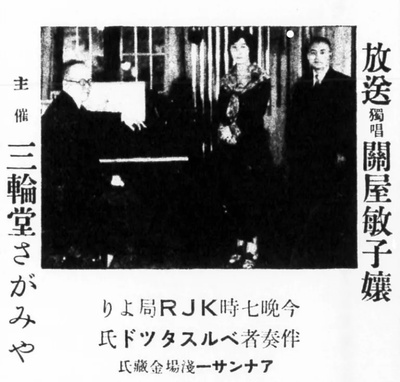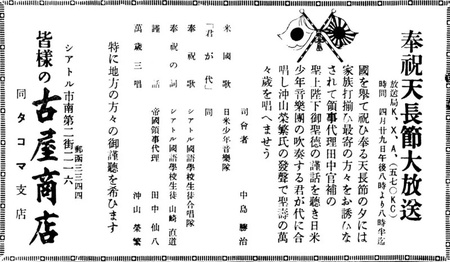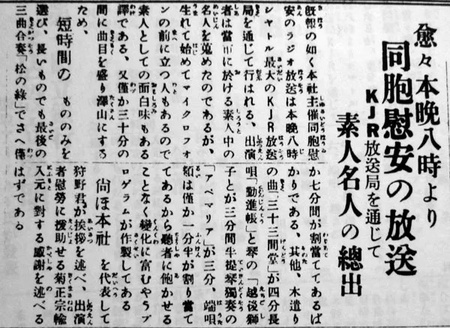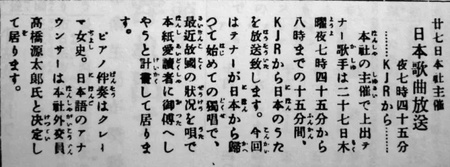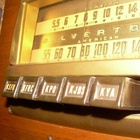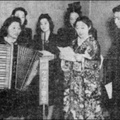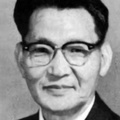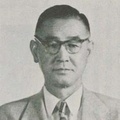Miwado
As of January 1931, KFQW aired Nakamura Watch Shop's "Japanese Music Broadcast" (2nd period) every other Thursday, but on weeks when this program was not aired, Japanese music also began to be broadcast at the same time (7:30-8:00 pm). The program was sponsored by Miwado, a retailer of books, magazines, stationery, photographic equipment, and more. This meant that Japanese music could be enjoyed on the radio every Thursday. The program is thought to have already started in 1930, but since no Japanese newspapers from that year have been preserved, it is not possible to determine when Miwado's program began.
Like the Nakamura Watch Shop program, the show usually featured records of Chikuzen biwa, rakugo, rokyoku, nagauta, kouta, and children's songs, but also featured live music. For example, a duet of whistling pieces "Kojo no Tsuki" and "Hakamairi" by whistling master Ernest Nickel, who visited Seattle, and Seattle whistling icon Arai Yone, a whistling master, "Nagashi no Eda" (Earth of the Ruined Castle) and nagauta "Tama River" by Nakatani Fukuko of Hatsune-kai, and "Kawanakajima" by Yamaguchi Nozomi, a master of Satsuma biwa (Kinshin-ryu) who toured the United States. The final broadcast was probably on May 7, 1931, coinciding with the end of Nakamura Watch Shop's "Nihon Ongaku Broadcast" (second period).
Miwado later merged with Sagamiya to become Miwado Sagamiya Shoten, a store that sold Victor and Columbia radio phonographs and records. The store took advantage of soprano singer Sekiya Toshiko's visit to Seattle and planned a one-off program on KJR on October 9, 1931, in which Sekiya would sing a solo song. The program for that night included "Hamauta," "Edo Lullaby," "Ai-Ai-Ai" (Spanish), "Night Melody," and "The Barber of Seville" (Italian), and was announced by Asaba Kinzo. The store, which stocked Japanese records, was also keen to promote Sekiya, offering a handwritten autograph to customers who bought five or more records.
Furuya Shoten
Masajiro Furuya (from Yamanashi Prefecture), considered one of Seattle's most successful businessmen, started out as a tailor and opened Furuya Shoten, a store that handled Japanese and American grocery items. He eventually opened branches in Tacoma, Portland, Vancouver, and even Japan, and even expanded into the financial industry. Furuya Shoten sponsored a Tencho-setsu celebration broadcast on KXA at 8 p.m. on the birthday of Emperor Showa on April 29, 1931.
The program consisted of a unison singing of Japanese and American anthems by Japanese and American youth bands, a congratulatory song by the Seattle Japanese Language School student choir, congratulatory words by Yamazaki Naomichi, a speech by Acting Consul Tanaka Senpachi, and three cheers by Okiyama Eishige (president of the Japanese Association of North America Chamber of Commerce). Announcements were made by Nakajima Katsuji (Wagaya), who has served as secretary of the Japanese Association of North America and as a North American current affairs reporter.
Although Furuya Shoten had been doing very well at one time, it was forced to close down in October of the same year due to financial difficulties caused by the Great Depression. As a result, the store's Japanese language broadcast ended as a one-off for that year.
The Great Northern Daily News
The Japanese language newspaper Daihoku Nippo, which had been edited and published in Seattle since 1910, began radio broadcasting. This was planned "to thank our many loyal readers scattered throughout Washington, Idaho, Utah, Oregon, and Montana, as well as our fellow countrymen, for their continued patronage" (Daihoku Nippo, October 9, 1933 issue), and was broadcast a total of three times by KJR, which has a wide service area.
The first program was broadcast on October 12, 1933, for 30 minutes from 7:45 pm. The program was sponsored by Wonder Bread Company and Takahashi Shokai, the importer of Kiku Masamune, and featured a concert by tenor singer Kamide Masataka. Kamide had stayed in Hawaii as a pastor for the Japanese Association, and later became a tenor singer and, after the war, a commissioned interpreter for the US State Department. On the day, the selection of songs was centered on Japanese music, including "Hoko wo Samete." There was also a phone call asking for "Kojo no Tsuki" to be sung, but due to the time being tight, it was not possible to fulfill the request. The announcement was made by Takahashi Gentaro, a salesman for the Daihoku Nippo newspaper.
The second broadcast was on February 7, 1934, from 8:00 pm for 30 minutes. Takahashi Shokai was also the sponsor. Following a greeting from Kano Terumitsu of the Daihoku Nippo (who later joined North American Jiji), amateur masters living in Seattle, such as Kimura Kenji, Saito Chikuso, and Tanaka Teruji, performed live Nagauta, Dan-uta, violin solo, Echigo lion, and sankyoku ensemble. The Daihoku Nippo later reported that the program had received a great response from all quarters, and that a letter of thanks had been received from a listener in Teresa, Montana.
The third broadcast was a 15-minute broadcast of Japanese songs from 7:45 pm on September 27, 1934. The familiar announcer was Takahashi Gentaro, and tenor Kamide Masataka, who appeared in the first episode, appeared again. Kamide returned to Japan for a short time immediately after the first broadcast for concerts and studies, and in order to demonstrate the results of his stay in Japan, he sang Japanese songs such as "Yoyokose Akita no Komoriuta" ("Yoyokose Akita no Komoriuta" ("Lullaby of Akita"), saying, "I want ordinary compatriots to feel the current Japan through song" (Daihoku Nippo, September 25, 1934 issue).
The final episode will cover the Japanese American Courier radio program, published by second-generation Japanese-American James Sakamoto, and its demise.
*This article is an excerpt from Japan Hour (2020) and reprinted from North American Newspaper (January 22, 2022).
© 2022 Tetsuya Hirahara


